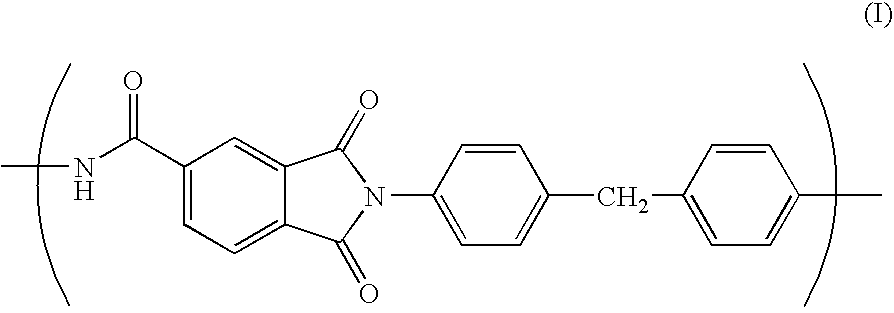Porous film, process for producing the same, and lithium-ion secondary cell made with the same
a lithium-ion secondary cell and porous film technology, applied in the direction of cell components, electrochemical generators, cell component details, etc., can solve the problems of insufficient insulating properties during shutdown, and spouting contents, so as to achieve excellent balance between shutdown properties and meltdown properties, the effect of reducing gas permeability and reducing the deterioration of cell cycle characteristics
- Summary
- Abstract
- Description
- Claims
- Application Information
AI Technical Summary
Benefits of technology
Problems solved by technology
Method used
Image
Examples
example 1
[0052] 1 mol of trimellitic anhydride, 0.5 mol of 1,5-naphthalene diisocyanate, 0.49 mol of 4,4′-diphenylmethane diisocyanate and 0.02 mol of potassium fluoride were charged together with N-methyl-2-pyrrolidone into a four-necked flask with a thermometer, a cooling pipe and a nitrogen gas inlet tube so as to meet a solid content concentration of 20%, stirred at a temperature of 120° C. for 5 hours, and thereafter diluted with N-methyl-2-pyrrolidone so as to meet a solid content concentration of 15% to synthesize a polyamide-imide resin. The inherent viscosity of the obtained polyamide-imide resin was 1.08 dl / g, the glass transition temperature was 320° C., the structural formula (I) was 50 mol % and the amide bond / imide bond ratio was 50 / 50.
[0053] 100 parts of the polyamide-imide resin solution was blended with 20 parts of polyethylene glycol (a number-average molecular weight of 400), applied on one surface of a polyolefin porous film (a thickness of 25 μm) manufactured by TonenGe...
example 2
[0054] Instead of an acid component of Example 1, 0.9 mol of trimellitic anhydride, 0.1 mol of benzophenone tetracarboxylic anhydride, 1.0 mol of 4,4′-diphenylmethane diisocyanate and 0.02 mol of potassium fluoride were charged together with N-methyl-2-pyrrolidone so as to meet a solid content concentration of 20%, stirred at a temperature of 100° C. for 3 hours, and thereafter diluted with N-methyl-2-pyrrolidone so as to meet a solid content concentration of 15% while cooled to obtain a polyamide-imide resin. The glass transition temperature of this polyamide-imide resin was 300° C., the inherent viscosity was 1.23 dl / g, the structural formula (I) was 90 mol % and the amide bond / imide bond ratio was 45 / 55.
[0055] The polyamide-imide resin solution was applied on one surface of a polyolefin porous film (25 μm) manufactured by TonenGeneral Sekiyu K.K. so as to meet a dried film thickness of 1 μm, immersed in water, and coagulated, washed and dried to prepare a composite porous film h...
example 3
[0056] A polyamide-imide resin was synthesized on the same conditions as Example 1 except for replacing an acid component of Example 1 with 0.92 mol of trimellitic anhydride, 0.08 mol of a poly(acrylonitrile-butadiene) copolymer with dicarboxylic acid at each end (Hiker CTBN1300×13 manufactured by Ube Industries, Ltd.), 0.7 mol of 1,5-naphthalene diisocyanate, 0.29 mol of 4,4′-diphenylmethane diisocyanate and 0.02 mol of potassium fluoride. The inherent viscosity of the obtained polyamide-imide resin was 0.69 dl / g, the glass transition temperature was 180° C. and the content of the structural formula (I) was 27 mol %. A composite porous film was prepared from this polyamide-imide resin solution in the same manner as Example 1. The film thickness of this composite porous film was 28 μm, the gas permeability was 410 sec / 100 ccAir, the shutdown temperature was 123° C. and the meltdown temperature was 200° C. or higher.
PUM
| Property | Measurement | Unit |
|---|---|---|
| glass transition temperature | aaaaa | aaaaa |
| thickness | aaaaa | aaaaa |
| glass transition temperature | aaaaa | aaaaa |
Abstract
Description
Claims
Application Information
 Login to View More
Login to View More - R&D
- Intellectual Property
- Life Sciences
- Materials
- Tech Scout
- Unparalleled Data Quality
- Higher Quality Content
- 60% Fewer Hallucinations
Browse by: Latest US Patents, China's latest patents, Technical Efficacy Thesaurus, Application Domain, Technology Topic, Popular Technical Reports.
© 2025 PatSnap. All rights reserved.Legal|Privacy policy|Modern Slavery Act Transparency Statement|Sitemap|About US| Contact US: help@patsnap.com



